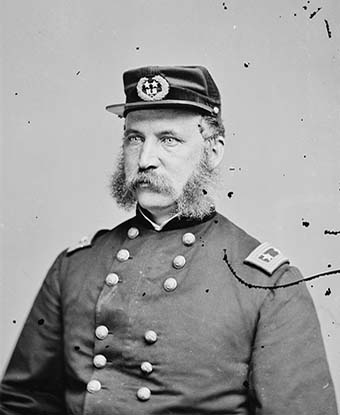Last updated: August 14, 2020
Person
John G. Foster

Library of Congress
John Gray Foster was born on May 27, 1823 in Whitefield, New Hampshire. An 1846 graduate of West Point, he served as an engineer in the war with Mexico where he was wounded. He was then an instructor at West Point, and in 1858, he was assigned to Charleston as a captain of engineers to oversee the underway construction of Fort Sumter. He was with Major Robert Anderson’s US Army garrison at Fort Sumter when on April 12, 1861, Confederate guns opened fire causing Anderson to evacuate two days later. Little did Foster know then that three years later he would return to lead Union efforts to reclaim Fort Sumter and occupy Charleston.
After leaving Charleston, he served in North Carolina under Maj. Gen. Burnside. In July 1862, he was appointed to the rank of Maj. Gen. of volunteers and commanded the Department of North Carolina until December of 1863. He was then sent to Tennessee and assigned command of the Army and Department of the Ohio. He was there only a short time before being injured when a horse fell on him. Despite the passage of the Emancipation Proclamation, which allowed the enlistment of African Americans into the US Army, Foster never supported the use of black soldiers and never attempted to enlist them.Recovering from his injuries, he assumed command of the Department of the South on May 26, 1864, where one of his priorities would be the capture or destruction of Fort Sumter.
Foster returned to Charleston Harbor with energy. He immediately conferred with Admiral John A. Dahlgren, the US Navy blockade commander to coordinate operations. He ramped up the bombardment of the city as well as of Forts Sumter and Johnson. He made plans to assault Fort Sumter and requested assault boats and a large scaling ladder to allow soldiers to scale the wall simultaneously. However, resources were being demanded from both the Army and Navy for use in other sectors, thus Foster was left without support for these and other schemes he later proposed. So, he could only continue to try to bombard the fort into submission.
By September, the supply of ammunition and powder had dwindled substantially as these resources were being diverted to support Grant’s and Sherman’s campaigns. Foster’s requests for more heavy guns was also denied, thus what was deemed the Third Great Bombardment that had lasted sixty days with 14,666 rounds fired at the fort, ended on September 4, 1864. Only haphazard firing occurred from then until the Confederates abandoned Fort Sumter on the night of February 17, 1865.
Still suffering from old war wounds and the accident with his horse a year earlier, Foster took a leave of absence on February 6, 1865, just two weeks before the Confederates evacuated Charleston. He was replaced by Maj. Gen. Quincy A. Gillmore, who had previously commanded the Department of the South from June 1863 until May 1864 and, during that period, had sought unsuccessfully to capture or destroy Fort Sumter.
After the war, Foster served in the regular army engineers attaining the rank of colonel. He was noted for his work in military and underwater surveying, becoming an expert in underwater demolition. He served as an assistant to the Chief of Engineers in Washington, DC for several years. His last duty station was at a post on Lake Erie. He died on September 2, 1874 in Nashua, New Hampshire.
